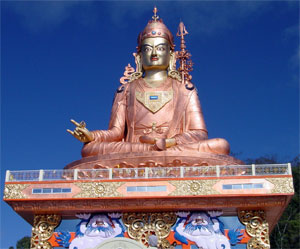The Nyingma Sect of Tibetan Buddhism
When Shakyamuni Buddha was preparing to die, his followers lamented that he had only taught the exoteric teachings of the lesser and greater vehicles (Hinayana and Mahayana) but had not taught the esoteric tantric teachings of the Vajrayana. Shakyamuni said that since he was born of a womb his current body was not suitable for introducing the tantric teachings but that he would come back in a miraculously-born form to reveal those teachings. As predicted, after 25 years he was born from a
he had only taught the exoteric teachings of the lesser and greater vehicles (Hinayana and Mahayana) but had not taught the esoteric tantric teachings of the Vajrayana. Shakyamuni said that since he was born of a womb his current body was not suitable for introducing the tantric teachings but that he would come back in a miraculously-born form to reveal those teachings. As predicted, after 25 years he was born from a
lotus in the form of Guru Padma Sambhava (“Guru Rinpoche”). Though Guru Rinpoche was a fully enlightened manifestation, he entered into and attained all of the stages of training as an example for others to follow. He not only mastered all of the teachings and attained realization and liberation, he also perfected the Vajrayana practices of skillful means which enabled him to perform miracles.
In Tibet, King Trisongdeutsan had been trying to establish Buddhism in Tibet but was unable to because of opposition by harmful spirits and sorcerers. A Bodhisattva advised the King that because of his vows of compassion and non-violence he could not overcome the negative forces but that the King should invite Guru Rinpoche who would be able to conquer them. At the invitation of the King, Guru Rinpoche came to Tibet in the 8th century and conquered and/or converted the negative forces forcing many of them to vow to protect the Dharma (Buddhism). He established what is now know as the Nyingma (lit. “Ancient”) sect of Buddhism. More recent sects of Buddhism in Tibet came from later transmissions of Buddhism from India to Tibet.

